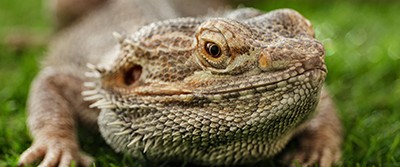Reptile brain may hold secrets to human sleep patterns

By Kevin Ritchart
The Australian bearded dragon may hold the key to unlocking the mysteries of sleep in humans.
A recent study examined the sleep-related neural signals in a specific region of the bearded dragon’s brain and linked them to a specific area of the mammalian brain. The study suggests that complex sleep evolved earlier in vertebrate evolution than originally thought.
This information could reveal more about the mechanisms behind sleep and clear a path for future studies aimed at helping humans get a better night’s sleep.
“Answers to the questions raised and reframed by this research seem extremely likely to be significant in many ways, including clinically,” says Stephen Smith, a neuroscientist at the Allen Institute.
Dreaming of Better Sleep
Mammals and birds take part in two kinds of sleep. During rapid eye movement (REM) sleep, eyelids flutter and electrical activity moves through the brain. In humans, this is the type of sleep where dreaming occurs.
Between REM periods is what’s known as slow wave sleep, when brain activity ebbs and electrical activity resets. This less intense state may help us form and store additional memories, based on the results of some studies.
In 2016, neuroscientist Gilles Laurent of the Max Planck Institute for Brain Research discovered that reptiles also display both types of sleep. The central bearded dragon, known as Pogona vitticeps, switches between the two sleep states every 40 seconds.
The Research
Laurent and his team used electrodes to locate the electrical activity associated with slow wave patterns in slices of dissected bearded dragon brains. Electrical activity often persists after death. They soon identified a small part of the dorsal ventricular ridge, a region located toward the front of the lizard’s brain whose function was unknown — until now.
Maria Tosches, a member of Laurent’s team and now an assistant professor at Columbia University, and two graduate students were assessing gene activity in cells from different parts of the lizard’s brain and comparing that activity with the brain of a mouse.
The set of genes active in the reptilian brain region that generated the slow wave pattern closely resembled the claustrum, an irregular grouping of nerve cells located deep in the mouse brain with connections throughout the forebrain. The resemblance indicated that reptile brains also have a claustrum.
“The claustrum has been a mystery for quite a while,” says Yang Dan, a neuroscientist at the University of California, Berkeley, who studies sleep circuitry in mouse brains.
Previous research had suggested the claustrum was an important part of consciousness, but the connection to sleep (and reptiles) was not immediately considered.
Like the mammalian claustrum, the lizard’s claustrum connects to many parts of the brain, including areas involved with sleep. When they damaged the claustrum, the dragon still slept, but no slow wave pattern was generated.
Responding to Signals
In reptiles and possibly other vertebrates, Laurent now believes a claustrum doesn’t start or stop sleep, but instead responds to signals from somewhere deeper in the brain. Then, it generates the slow wave pattern and transmits it to other parts of the brain.
Laurent’s team also found a claustrum in a distant reptilian relative, the Trachemys scripta turtle, leading researchers to conclude that the claustrum predates the evolution of reptiles. New research suggests the claustrum and its role in sleep date back as many as 320 million years to the ancestor of birds, other reptiles, and mammals.
That means the claustrum’s role in mammalian sleep should be investigated, especially in humans.
“If the claustrum is important for sleep in reptiles, it might also be important for sleep and sleep disorders in humans,” said Terrence Sejnowski, a computational neuroscientist at the Salk Institute for Biological Studies in San Diego, California.
No matter what future research might indicate, this discovery shows that reptiles can provide a window into the world of vertebrate brain evolution.
Discussion Questions
- Can you think of any sleep disorders that might be helped by further research on animal brain activity?
- In addition to sleep, what other functions performed by the body could we learn about by comparing our brains with those of other species?
Vocabulary
- neural
- mammalian
- claustrum

